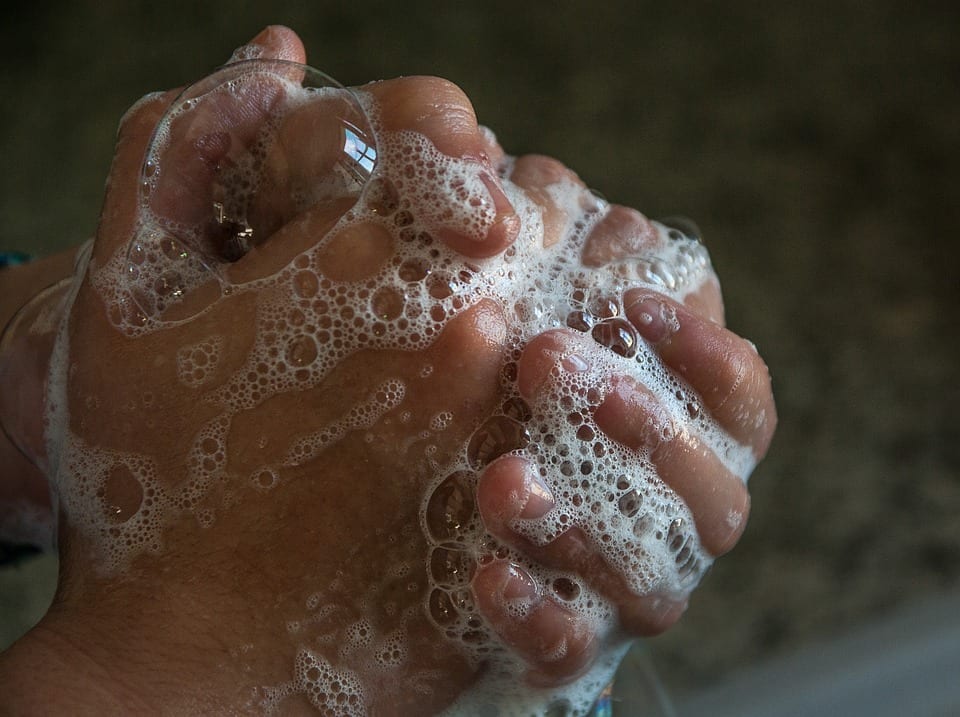Handwashing, when done correctly, is the single most effective way to prevent the spread of communicable diseases. Good handwashing technique is easy to learn and can significantly reduce the spread of infectious diseases in both children and adults.
What types of diseases can good handwashing prevent?
![]() Handwashing can prevent many diseases including diseases spread through fecal-oral transmission, such as:
Handwashing can prevent many diseases including diseases spread through fecal-oral transmission, such as:
- shigellosis,
- hepatitis A,
- E. coli 0157:H7
- enterovirus.
![]() Because these diseases are spread through the ingestion of even minute particles of fecal material, it is very important to wash hands right after going to the restrooms.
Because these diseases are spread through the ingestion of even minute particles of fecal material, it is very important to wash hands right after going to the restrooms.
![]() Handwashing also prevents diseases spread through indirect transmission, such as:
Handwashing also prevents diseases spread through indirect transmission, such as:
- influenza,
- streptococal disease,
- respiratory syncitial virus (RSV),
- and the common cold.
![]() Because these diseases maybe spread indirectly by hands freshly soiled by respiratory discharges of infected people, illness may be avoided by washing hands after coughing or sneezing. Diseases may also be spread when hands are contaminated with urine, saliva, or other moist body substances. Infections which may be transmitted by one or more of these body substances include:
Because these diseases maybe spread indirectly by hands freshly soiled by respiratory discharges of infected people, illness may be avoided by washing hands after coughing or sneezing. Diseases may also be spread when hands are contaminated with urine, saliva, or other moist body substances. Infections which may be transmitted by one or more of these body substances include:
- cytomegalovirus (CMV),
- staphylococcal organisms,
- typhoid, …
![]() These germs may be transmitted from person to person, or indirectly by contamination of food, or inanimate objects such as toys.
These germs may be transmitted from person to person, or indirectly by contamination of food, or inanimate objects such as toys.
What is good handwashing technique?
![]() There is more to handwashing than you think ! Rubbing your hands vigorously with soapy water, pulls the dirt and oily soils free from your skin. The soap lather suspends both the dirt and germs inside bubbles where they can quickly be washed away.
There is more to handwashing than you think ! Rubbing your hands vigorously with soapy water, pulls the dirt and oily soils free from your skin. The soap lather suspends both the dirt and germs inside bubbles where they can quickly be washed away.
![]() Follow these four simple steps to keep hands clean:
Follow these four simple steps to keep hands clean:
- Wet your hands with warm running water
- Add soap, then rub your hands together making a soapy lather. Do this away from the running water for at least 10 seconds, being careful not to wash the lather away. Wash the front and back of your hands, as well as between your fingers and under your nails.
- Rinse your hands well, under warm running water. Let the water run back into the sink, not down your elbows.
- Dry hands thoroughly with a clean towel.
What type of soap should be used ?
![]() Any type of soap may be used. However, bar soap should be kept in a self draining holder that is cleaned thoroughly before new bars are put out. Liquid soap containers (which must be used in day care centers) should be used until empty and cleaned before refilling.
Any type of soap may be used. However, bar soap should be kept in a self draining holder that is cleaned thoroughly before new bars are put out. Liquid soap containers (which must be used in day care centers) should be used until empty and cleaned before refilling.
 What are some things I should avoid regarding handwashing ?
What are some things I should avoid regarding handwashing ?
- Don’t use a single damp cloth to wash a group of children’s hands.
- Don’t use a standing basin of water to rinse hands
- Don’t use a common hand towel. Always use disposable towels in a day care or school
- Don’t use sponges or non-disposable cleaning cloths unless you launder them on a regular basis, adding chlorine bleach to the wash water. Remember that germs thrive on moist surfaces !
How to teach children good handwashing technique?
![]() It is important to encourage and help children to wash hands before eating, after playing outdoors or playing with pets, after using the bathroom, and after blowing their noses.
It is important to encourage and help children to wash hands before eating, after playing outdoors or playing with pets, after using the bathroom, and after blowing their noses.
Even though hands may appear clean, they may carry germs or microorganisms that are capable of causing disease. Don’t assume that children know how to wash their hands properly. Supervision, especially in a day care setting, is an essential element in forming good handwashing habits in children.
Finally, children learn by example! Let them observe good handwashing technique from adults who care for them.





Be the first to comment on "Facts about Handwashing"